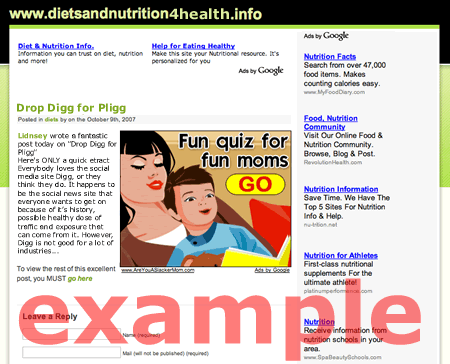 For a new blogger, getting comments or trackbacks is exciting. However, some of them could be automated spambots filling up your comments with links to sites you wouldn’t want your visitors seeing. Spam plugins can do wonders at stopping spam, but some manual work is required. Here are a few tricks to help new bloggers identify possible spam.
For a new blogger, getting comments or trackbacks is exciting. However, some of them could be automated spambots filling up your comments with links to sites you wouldn’t want your visitors seeing. Spam plugins can do wonders at stopping spam, but some manual work is required. Here are a few tricks to help new bloggers identify possible spam.
1- What name did the commenter leave? Was it Sam or Jill? Or was it Used Cars or Baby Blankets? Most spammers use keyword phrases as they think it’ll help out their site; which it won’t.
2- What URL did they leave as their homepage? Does the URL look like a laundry list of keywords? http://www.shop-for-ipods.com/ipod-deals/best-ipod-prices.htm. Trying to hard is an indication that the link may be spam.
3- Was their comment generic? Sure, not everyone leaves detailed comments, but an indication of spam may be a comment such as “Great Website”,”I’m really glad I found your blog”, “This is really good content.” Chances are that these comments came from someone who never read your post.
4- Visit the URL. Not for the faint of heart, but if you can’t tell from the indicators above, check out the website and see if it looks like a legit website. Those that are spam are probably filled with ads, have no unique content and probably no real structure.
5- Is it readable? Some spammers like to put in symbols for some odd reason. No matter how you translate it, it doesn’t become readable. If the comment doens’t contain characters that even look vaguely familiar, it may just be spam.
6- Is your name Thomas but they call you Lindsey? Ok, this is a good one. Spam bloggers will quote your blog post and link back to you. However, they quote you as someone else. What’s happening is they have an automated system to pull content and then they add a name to it to make it look more realistic.
7- Does the other site topic match yours? Since spam is usually automated, a pet site may grab any content that has pet related keywords. If you talk about how you’ve been working like a dog, your post may get associated as a pet post. That’s even more evidence that no one is really reading your post, they are just taking it to populate their site.
There is not one give away for identifying all spam trackbacks or comments. Some may have a few of the tactics mentioned above and still be real. It’s up to you, the blog editor, to decide what to keep and what to remove.
The web is a wonderful place, but nothing is off limits to the spammers of the world who try to ruin the fun for everyone. Always keep an eye on your comments for the spammers as they will come. Not only do you want to build a good reputation for your site, but you want to ensure that those comments left by others don’t hurt the identity you want to promote.
Remember, you are in control of your site. You have the right to edit or delete any comments you don’t feel are acceptable.
Example: Can you tell why this site is spam?



